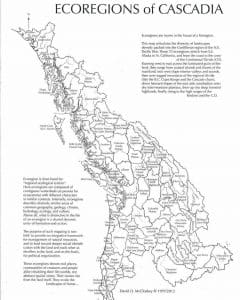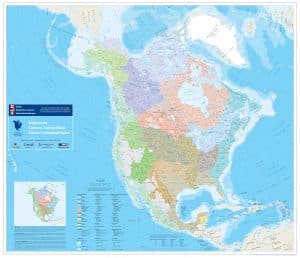Watershed, Ecoregion, Bioregion – What’s the deal?
While Bioregions are often defined by hard, jagged edges – within each bioregion the boundaries are frequently more nuanced. They can be soft, and often blur together. These areas exist as collections of watersheds, otherwise known as “eco-regions”, short for regional ecosystems.
So, watersheds and ecoregions… how are they defined and what’s the difference?
A watershed is a marvelous thing to consider: this process of rain falling, streams flowing and oceans evaporating causes every molecule of water on earth to make the complete trip once every two million years. The surface is carved into watersheds-a kind of familial branching, a chart of relationship, and a definition of place. The watershed is the first and last nation whose boundaries, though subtly shifting, are unarguable. For the watershed, cities and dams are ephemeral, of no more account-than a boulder that falls in the river of a landslide that temporarily alters the channel. The water will always be there, and it will always find its way down. We who live in terms of centuries rather than of years must hold the watershed and its communities together, so our children might enjoy the clear water and fresh life of this landscape we have chosen.
Gary Snyder
A watershed is an area of land that drains all the streams and rainfall to a common destination such as a bay, lake or ocean. Watersheds can be large or small, and are often divided by natural ridges and hills. Watersheds are entirely concerned with the travel of water – from where rainfall lands, or underground water runs – all the way on it’s journey to the place it flows no more. Watersheds consists of surface water–lakes, streams, reservoirs, and wetlands–and all the underlying groundwater. Larger watersheds contain many smaller watersheds.
All land on earth is part of a watershed. Humans and their activities play an important and essential role in watersheds, yet few people understand them. Still fewer know the dynamics and boundaries of the ones in which they live. A watershed is a system. It is the land area from which water, sediment, and dissolved materials drain to a common watercourse or body of water. For each watershed there is a drainage system that conveys rainfall to its outlet.
A watershed may be the drainage area surrounding a lake that has no surface outlet, or a river basin as large as that of the Columbia River. Within a large watershed are many smaller watersheds that contribute to overall streamflow. The point where two watersheds connect is called a divide. A watershed is drained by a network of channels that increase in size as the amount of water and sediment they must carry increases. Streams are dynamic, open water systems with channels that collect and convey surface runoff generated by rainfall, snowmelt, or groundwater discharge to the estuaries and oceans. The shape and pattern of a stream is a result of the land it is cutting and the sediment it must carry
A watershed is the smallest unit we look at as bioregionalists. It is the area created from where a rain drop falls or a spring bubbles to the surface, to the body of water it connects to. Ecoregions are comprised of these watersheds, and are used to make up the areas of a bioregion. Ecoregions are similarly defined, but are expanded to include, physical, biological, and human realities that may stem from these areas. Watersheds, like Cascadia, transcend arbitrary borders, and are critical in understanding where our water comes from, and where it goes, as well as engaging with all of the communities affected by that discussion. Creating these holistic cultural, economic, ecological and democratic systems are why ideas like Cascadia are so important. The Columbia River watershed alone, the largest in Cascadia, includes parts of six US states and one Canadian province. Its border is traced, “not by governments or treaties, but by every drop of liquid that finds a common path to the ocean”.
Watersheds are important because the streamflow and the water quality of a river are affected by things, human-induced or not, happening in the land area “above” the river. Watersheds are so critical for bioregionalism because, like Cascadia, they transcend arbitrary borders, and are critical in understanding where our water comes from, and where it goes, as well as engaging with all of the communities affected by that discussion. Creating these holistic cultural, economic, ecological and democratic systems are why ideas like Cascadia are so important. The largest watershed in North America is the Mississippi River Watershed, which drains 1.15 million square miles from all or parts of 31 U.S. states and two Canadian provinces stretching from the Rockies to the Appalachians.
 Ecoregions: An Ecoregion is comprised of these watersheds, and are used to make up the areas of a bioregion. They are thought of as “the rooms” within a bioregion. Ecoregions are similarly defined, but can include several similar watersheds and are expanded to include, physical, biological, and human realities that may stem from these areas. Cascadia in total has 75 ecoregions, reflecting areas of similar flora, fauna, geology, soil composition and rainfall patterns.
Ecoregions: An Ecoregion is comprised of these watersheds, and are used to make up the areas of a bioregion. They are thought of as “the rooms” within a bioregion. Ecoregions are similarly defined, but can include several similar watersheds and are expanded to include, physical, biological, and human realities that may stem from these areas. Cascadia in total has 75 ecoregions, reflecting areas of similar flora, fauna, geology, soil composition and rainfall patterns.
Ecoregions are another way to say ‘ecosystem’ – an area with characteristic flora, fauna, and climatic conditions – and can be comprised of several different watersheds, if the plants and animals are similar. Humans settlement patterns are included within an ecoregion, because humans have a large impact on their surrounding ecosystem, and in reverse, ecosystem plays a large part in how humans adapt, settle and build. In terms of size, an ecoregion is larger than a watershed and smaller than a bioregion; or in political terms, larger than a county and smaller than a state or province. There are 75 ecoregions in Cascadia, and of the more than 750,000 square miles of Cascadia, ecoregions average about 10,000 square miles each, though ranging from 2,000 to over 30,000 square miles. Ultimately the size of each depends upon the unique character and context of the place itself. Reflecting this, policy planners have increasingly shifted to watershed and ecoregional planning frameworks to create a more holistic approach to stop dealing with single issues, or ‘point-source’ problems, to broader, regional approaches that greater take in an entire area, those most affected, and create better solutions
Bioregion: Lastly, we use the scale of the bioregion – a region whose limits are naturally defined by topographic features (such as mountain ranges and rivers) and biological features (such as plants, animals, humans and entire ecosystems). Culture is a sum of our personal and interpersonal relationships and choices, many of which are defined shared values and need which arise from sharing a place. A bioregion is the most efficient, and largest physical scale on which these cultural connections that arise from place will make sense and serve as containers on which to break down large, intangible issues, onto a local level from which every person can walk out their door, and get active. It must necessarily include each watershed within it, because you cannot have a discussion about only parts of each. Cascadia is a land of flowing waters, and for the Cascadia bioregion, it is the topographic region that is defined from which a drop of rain hits the western side of the continental divide – and flows into the Pacific – from the headwaters of the Fraser and Columbia, to the headwaters of the Snake, which stems from the Yellowstone caldera.
“While there are few straight lines in nature, there are many definite and powerful edges—various ecotones, watershed divides, climatic zones, fault-lines and scarps. Careful attention should be given to such beginnings and endings, for these dramatic turnings in the earth serve as clear and powerful articulations of diversity.”
– David McCloskey
On Bioregional Boundaries
Bioregions are the natural countries of the planet, containing within them many nations, inhabitants, watersheds and ecosystems.
Boundaries in of themselves are not good or bad. They define the edges of things. Places where different zones meet and collide. Unlike many borders in our world today, bioregional boundaries are not an abstraction given to a place. Rather they are real, physical features which can be seen, felt, measured, and tested.
Reflecting this, federal policy planners have increasingly shifted to watershed and ecoregional planning frameworks. Government agencies at the regional, state, national and international levels are working to adopt more holistic approaches to stop dealing with single issues, or ‘point-source’ problems, to broader, regional approaches that greater take in an entire area, those most affected, and create better solutions.
Together, with these three layers, the framework of a bioregion is the largest physical connection of scale that makes sense, and the furthest extent of it’s watersheds – because ultimately, every person and community living within a watershed must be able to substantively weigh in and contribute to those discussions which might impact them the most.
Key Takeaways:
How big is a bioregion? How is it’s scale defined? Below are a few key pointers:
- A bioregion is an area defined by natural boundaries, rather than arbitrary human made ones.
- A bioregion is the full extent of the watersheds within an interconnected area, the largest sense of scale based on physical similarities that makes sense.
- A bioregion can be made up of many ecosystems, soil patterns, weather types, and in terms of scale is larger than an ecoregion, and smaller than a continent.
- While borders within a bioregion may be transitional, soft and fuzzy, bioregional borders tend to be jagged, and hard, such as mountain ranges, peaks, ridges, volcanoes, continental uplifts, tectonic plates and faults. These hard edges define how energy flows within a set of boundaries.
- Bioregional boundaries don’t stop at waters edge, but should be stretched outwards until the physical edges reveal themselves.
- A bioregion is the smallest unit in which the ecosystems and inhabitants can be self sustaining. This includes human habitation (food, water, energy generation, production, transportation, consumption and waste streams). It can be as small as one island, or depending on the inhabitants, be a part of an archipelago or connected island chain.
- Bioregions are natural countries, which may contain many nations, inhabitants and peoples.
- Culture plays a part in defining bioregions. Humans play a large role as part of their ecosystems, and shared concerns, values, language and culture stem from sharing a land base.

